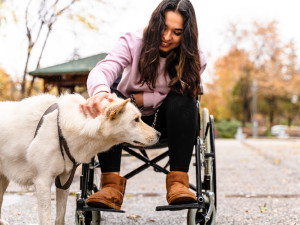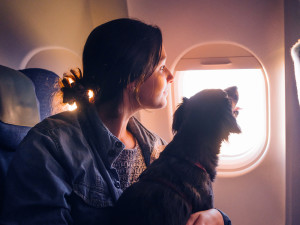What are the Training Requirements for Service Dogs?
Find out everything you need to know.

Share Article
In This Article:
What is a Service Dog? What are the Training Requirements for Service Dogs? How Does My Dog Become a Service Dog? What is the Difference Between a Service Dog and an Emotional Support Dog?
Service dogs are a necessity for many people with disabilities, assisting them with everyday tasks and alerting them to medical emergencies. In the United States, there are roughlyopens in new tab 500,000 trained service dogs working to provide assistance, comfort, and companionship to people living with disabilities
Registering your dog as a service animal grants them special access rights under the Americans with Disabilities Act to accompany you in public places. To determine whether your dog can be certified, and how to go about doing that, read our tips below. In this article you will find:
What is a service dog?
What are the training requirements for service dogs?
How does my dog become a service dog?
What is the difference between a service dog and an Emotional Support Animal?
Where to find a service dog?
What is a service dog?
A service dog is a dog specially trained to assist their human with tasks related to their disability. These dogs are considered to be at work when accompanying their handler, and are granted special public access rights that allow them to accompany their handlers in various public places where pets typically are not allowed.
How much do you spend on your pet per year?

Service dogs perform tasks such as guiding the visually impaired, alerting the deaf to sounds, providing mobility support, detecting medical conditions, and assisting with psychiatric conditions.
What does a service dog do?
Service dogs perform a variety of tasks to assist their handlers, depending on the handler’s medical disability. These tasks include but are not limited to:
Guide Dogs: Assist individuals who are blind or visually impaired in navigating their environment.
Hearing Dogs: Alert individuals who are deaf or hard of hearing to important sounds, such as doorbells, alarms, and phone calls.
Mobility Dogs: Help individuals with physical disabilities by retrieving objects, opening doors, and providing balance and support.
Medical Alert Dogs: Detect medical conditions such as seizures, low blood sugar, or other health issues and alert their handler to take necessary actions.
Psychiatric Service Dogs: Support individuals with psychiatric disabilities by performing tasks such as interrupting harmful behaviors, providing deep pressure therapy, and alerting to episodes of anxiety or PTSD.
What are common service dog breeds?
Common service dog breeds are known for their intelligence, trainability, and temperament. Below are some of the breedsopens in new tab experts say are most frequently seen in service dog roles. And don’t forget, almost any breed is available for adoption at your local shelter:
Labrador Retriever: Known for their friendly and outgoing nature, Labradors are highly trainable and versatile, making them excellent service dogs.
Golden Retriever: Similar to Labradors, Golden Retrievers are intelligent, gentle, and eager to please. They are often used as guide dogs and in therapy settings.
Poodle: These pups — particularly standard poodles — are known for their intelligence and hypoallergenic coat, making them a good choice for individuals with allergies.
Boxer: Their alertness, strength, and affectionate nature make Boxers suitable for roles requiring physical support and assistance.
Border Collie: With their high energy and intelligence, Border Collies excel in tasks that require problem-solving and agility.
Doberman Pinscher: Dobermans are loyal, intelligent, and protective, often used for personal protection and as service dogs for individuals with specific needs.
Where to find a service dog?
Service Dog Organizations: Many organizations breed, raise, and train service dogs to match with individuals with disabilities. Examples include PAWS With A Cause and Canine Companions for Independence.
Professional Trainers: Some trainers specialize in training dogs for service work and can help people with disabilities find trained dogs to adopt.
Self-Training: Individuals may choose to train their own dog to become a service dog. If you are in need of a service dog to assist with your disability, you can adopt a dog with a temperament amenable to service dog work and pay to have them trained yourself.
What are the training requirements for service dogs?
Service dogs undergo rigorous training to ensure they can effectively assist their handlers. All dogs have to undergo basic obedience training where they learn commands such as sit, stay, come, and heel which costsopens in new tab an average of $1,000-$2,500. Task-specific training can be a more costly endeavoropens in new tab — with basic mobility assistance training ranging from $15,000-$30,000, specialized task training from $25,000 to $40,000, and guide dogs or medical alert dogs up to $50,000.
There are options for funding this training, like nonprofit organizationsopens in new tab, veterans programsopens in new tab, and scholarshipsopens in new tab.
How to train your own service dog
For those who choose to train their own service dogs with professional help, hourly rates typically rangeopens in new tab from $150 to $250, which can add up to several thousand dollars over the course of training. To train your own service dog, follow the below steps:
Determine Eligibility: Ensure you have a disability that qualifies for a service dog under the Americans with Disabilities Act (ADA), with a diagnosis from a certified medical professional.
Training: Either train your dog yourself or enlist the help of a professional trainer, with the tips shared above. The dog must learn basic obedience, task-specific skills, and public access behavior.
Pass a Public Access Test: This test evaluates the dog's behavior and ability to perform tasks in public settings. The International Association of Assistance Dog Partnersopens in new tab (IAADP) and Assistance Dogs International (ADI)opens in new tab are two prominent organizations that administer public access tests for service dogs. These tests evaluate a dog's readiness to work in public settings and ensure they can handle various environments and distractions.
Certification and Registration: Although not legally required, some handlers choose to have their service dog certified and registered through reputable organizations for added legitimacy. The International Association of Assistance Dog Partnersopens in new tab (IAADP) and Assistance Dogs International (ADI)opens in new tab, carry out these tests.
What is the difference between a service dog and an emotional support dog?
Service dogs and emotional support animals (ESAs) both help their humans in their own ways, but they have distinct roles and legal rights.
An emotional support animal is a pet prescribed by a licensed mental health professional to provide comfort, companionship, and emotional support to individuals who are dealing with mental health conditions, such as anxiety, depression, or other psychological issues. Unlike service dogs, ESAs are not trained to perform specific tasks related to a disability and do not have the same public access rights as service dogs. However, ESAs are covered under the Fair Housing Act (FHA), allowing them to live with their owners in housing that typically has a "no pets" policy.
Service dogs are trained to perform specific tasks that assist individuals with disabilities, such as guiding the visually impaired, alerting the deaf to sounds, pulling a wheelchair, alerting to seizures, and calming a person with PTSD during an anxiety attack. Under the Americans with Disabilities Act (ADA), service dogs are granted public access rights, meaning they can accompany their handlers in most public places.
Is a dog in a vest a service dog?
Not necessarily! While many service dogs wear vests for identification, the vest alone does not signify that a dog is a service dog. Some dogs - like my dog Lucy - wear a vest that says “pet me!” because they are therapy dogs meant to be engaged with. Many service dogs are on the job when they are in a vest, and you are not supposed to pet themopens in new tab or engage with them. Proper training and task performance are required to qualify a dog as a service dog.
References
Winkle, M., Crowe, T. K., & Hendrix, I. (2012). Service dogs and people with physical disabilities partnerships: A systematic review. *Occupational Therapy International*, 19(1), 54-66. https://pubmed.ncbi.nlm.nih.gov/21858889/opens in new tab
U.S. Service Animals. Public access test for service dogs. Retrieved from https://usserviceanimals.org/blog/public-access-test-for-service-dogs/?form=MG0AV3opens in new tab
International Association of Assistance Dog Partners. (n.d.). IAADP minimum training standards for public access. Retrieved from https://iaadp.org/membership/iaadp-minimum-training-standards-for-public-access/?form=MG0AV3opens in new tab
U.S. Department of Justice.Service animals. Retrieved from https://www.ada.gov/topics/service-animals/ National Center for Biotechnology Information. *Title of the article*. Retrieved from https://pmc.ncbi.nlm.nih.gov/articles/PMC10670951/opens in new tab

Kari Paul
Kari Paul is a Paris-based writer, artist, and filmmaker whose work has been published in The Guardian, The Wall Street Journal, New York Magazine, ELLE, and VICE. She has had an endless march of more than 20 foster kittens, cats, and dogs over the last few years and always cries when they leave. She covers technology, personal finance, and animal behavior, among other topics.
Related articles
![Woman petting her small service dog.]()
What People Can and Can’t Ask You About Your Service Dog
The questions will come, so you should be prepared with answers.
![Backlit photo of a woman seated on an airplane holding her dog in her lap while they both look out of the open window.]()
You Can’t Fly With Your Your ESA, But Your PSD Is Welcome on a Plane
Find out how here, including what the heck those acronyms mean.
How to Register a Dog for The First Time
This step-by-step guide takes you through the process.
![A redheaded woman in a black hat and sunglasses holding her pug dog under her arm as well as two boarding passes and her passport in an airport hallway]()
10 Places Where Your ESA Is — and Is Not — Allowed
Not every public place allows ESAs — but there are ways to advocate for yourself and your needs when your pup or other ESA is not on the guest list.
![A woman laying on a zig zag patterned blanket while curling around her brown and white dog]()
How Do I Register an Emotional Support Animal?
Confused about ESA rules? Here’s a comprehensive guide that explains everything.
![Person holding a corgi, shot from behind]()
Flying with An Emotional Support Animal
Are ESA alpacas and peacocks mocking people with real disorders? A service-dog owner and flight attendant get real.









